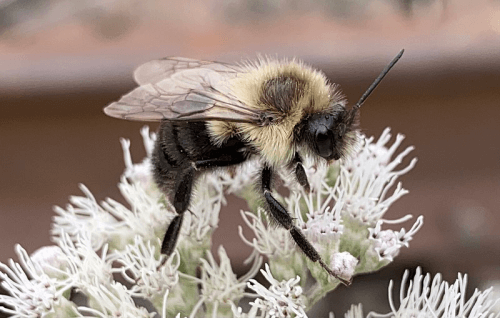The Function Of The Dufour's Gland In Bumble Bees
Does the Dufour’s gland of social bumble bees have the same function as in honey bees?
Here, we’ll look at the role of the Dufour’s gland in the biology of the bumble bee (Bombus).
The Dufour's Gland In Bumble Bees
Elsewhere, I have written about the Dufour’s gland in honey bees (Apis mellifera).
In honey bees, it has been shown that the purpose of the gland differs between queens and workers.
Studies suggest that the Dufour’s gland secretions of queens are part of the ‘queen signal’, which has numerous functions, including the regulation of reproduction, and instigating ‘worker policing’, whereby workers distinguish between queen-laid eggs and worker-laid eggs, and destroy worker-laid eggs.
In worker honey bees, it is proposed that the Dufour’s gland produces an alarm pheromone.
The bumble bee colony cycle is different from that of honey bees, but there are some similarities.
Initially, egg laying is performed only by the queen that established the colony, with worker bees being effectively sterile.
However, later in the colony cycle, workers may also initiate egg laying in competition with the queen.
This raises a question: does the Dufour’s gland of social bumble bees affect the functioning of the colony, as is the case with honey bees?
Derstine et al1 examined the Common Eastern Bumble Bee (Bombus impatiens) to find out.
Dufour's gland in Bombus terrestris
Derstine et al noted that studies on Bombus terrestris had suggested Dufour’s gland secretions vary depending on caste, reproductive state, age, and task and may effect behaviour.
 Bombus terrestris
Bombus terrestrisFor example, the presence of esters in workers may have an appeasement effect (thereby promoting harmony in the bumble bee colony), whereas workers with non-detectable amounts of esters may promote conflict since the absence of esters may signal fertility to other colony members, which can promote worker competition and aggression.
Dufour's gland in Bombus impatiens
Derstine et al set up an experiment to discover if the Dufour’s gland in Bombus impatiens signals information to other bees about caste, social condition, and reproductive status, with a particular interest in the potential role of Dufour’s gland secretions in the regulation and communication of reproductivity.
In doing so, they chemically analyzed the Dufour’s gland secretions from bees of different castes, ages, and reproductive status.
They also examined the responses (behavioural responses and antennae responses) of worker bees to the different extracts produced by the Dufour’s gland.
 Bombus impatiens - Common Eastern Bumble Bee
Bombus impatiens - Common Eastern Bumble BeeFindings from the study
According to the study, it appears there is a difference between the Dufour’s gland compound secretions of bees (Bombus impatiens) depending on role and caste (queen, gyne, worker) within the colony.
Derstine et al described this as:
“… the presence of caste-specific and physiology-specific compounds in Dufour’s glands of B.impatiens females.”
In particular, amounts and proportions of esters and hydrocarbons varied, depending on social status, age and reproductive status.
For example, there were four esters exclusive to workers, and diterpene compounds (hydrocarbons) present in queens and gynes were absent in workers.
In short, these esters, as well as the total amounts of hydrocarbons in the Dufour’s gland, provided a separation between castes and also between fertile and sterile workers.
Additionally, Derstine et al found that Dufour’s gland secretions appear to increase with age.
The study also examined antennal responses of workers to Dufour’s gland secretions and suggest that the Dufour’s gland secretions enable workers to discriminate among workers, with the scientists postulating that the discrimination leads to greater harmony within the colony.
Conclusion
In conclusion, it does seem that the Dufour’s gland secretions in bumble bees signal information about cast, age, social status, and reproductive status to other bees within the colony.
These signals ensure that there is cohesion within the colony by regulating reproductive behaviour and interaction between bees within the colony.
References
1. Derstine N.T. et al (2021) Dufour’s gland analysis reveals caste and physiology specific signals in Bombus impatiens. Sci Rep 11, 2821 (2021). https://doi.org/10.1038/s41598-021-82366-2
